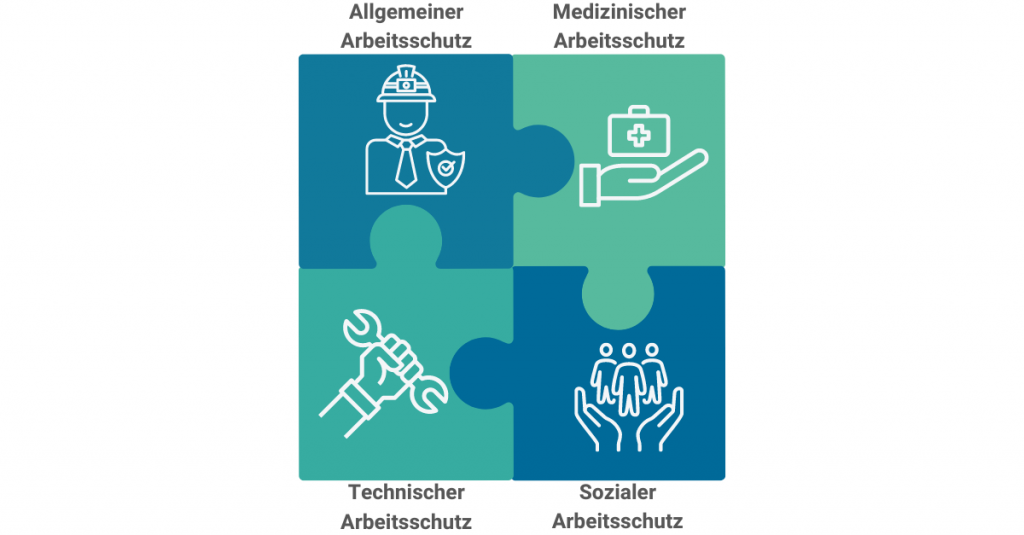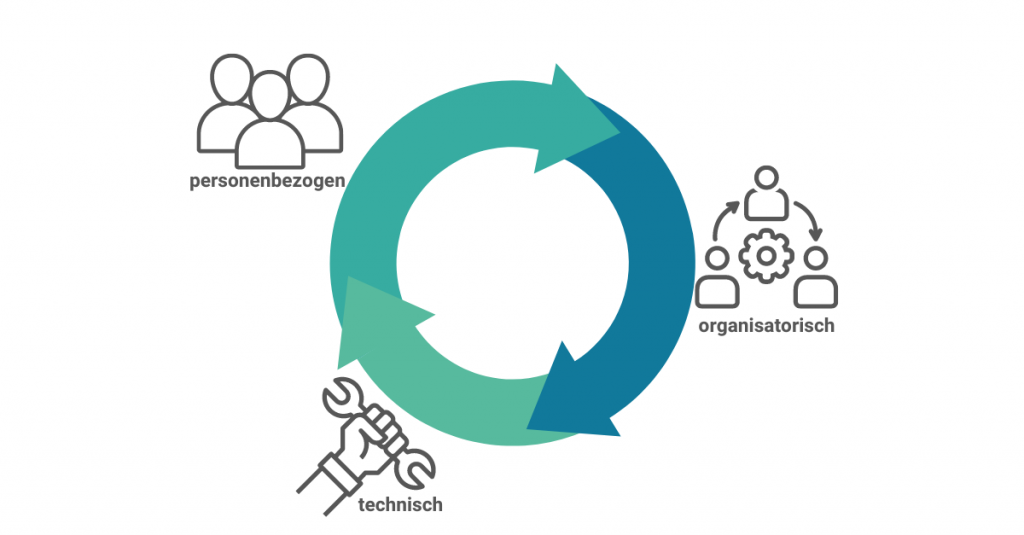
Occupational health and safety is one of the most important issues in a company. Employees who are exposed to hazards on a daily basis will not be able to work effectively. A safe workplace environment is needed to ensure the health of employees. You can find out exactly what occupational health and safety involves and what companies need to consider here.
Definition of occupational health and safety
Who is responsible for occupational health and safety?
The types of occupational health and safety
The occupational health and safety measures
The term occupational health and safety refers to rules, measures and strategies aimed at ensuring the health and safety of employees in the workplace. This includes the identification, assessment and control of risks and hazards associated with specific working conditions or working environments. Occupational health and safety is one of the three pillars of the occupational health management.
Probably the most important instrument in occupational health and safety is the risk assessment, which is laid down in the German Occupational Health and Safety Act (ArbSchG). Companies are therefore obliged to identify and eliminate hazards. This applies to both physical and mental hazards.
It is the employer's responsibility to ensure the safety of employees in their company. They must ensure that legal regulations are complied with and take measures to protect the health and safety of employees. However, the management, which acts as the legal representative of the company, is usually unable to fulfil this duty of care itself. They have other tasks. The Occupational Health and Safety Act therefore clearly regulates how duties can be delegated. These regulations must be complied with when tasks are transferred.
The legal basis for this delegation of obligations are the provisions of Section 13 (1) (5) and (2) of the Occupational Health and Safety Act in conjunction with Section 13 of DGUV Regulation 1. This means that the employer can authorise qualified and reliable persons in writing to carry out certain tasks independently. It is important that the delegated rights and tasks are recorded in writing and described precisely. In addition, the employer should define clear rules for cases of substitution, for example in the event of holidays or illness.
However, the employer remains responsible for ensuring that the occupational health and safety obligations are actually fulfilled.
In addition to company managers and executives, there are special positions that may be responsible for occupational health and safety. These include, among others:
It is important to understand that these persons only act in an advisory capacity and are not obliged to implement them. Sifa and SiBe normally have a clearly defined catalogue of tasks, which is specified by law and by the employers' liability insurance association. In contrast, many other authorised representatives do not have precise specifications as to which tasks they should perform in the company. As a result, they are usually only responsible for the tasks that are officially part of their duties.
However, this changes if they formally act as advisors to the employer but put their proposed measures into practice themselves. In such a case, they have a similar legal status to the employer and can be held liable accordingly.
Occupational health and safety covers four areas:

The focus is on the well-being of employees, with the aim of protecting their health and lives. According to §3 of the Occupational Health and Safety Act, employers are obliged to create safe working conditions. Employees are also obliged to follow instruction and instructions and thus ensure their health and safety (§15 ArbSchG).
Medical occupational health and safety focuses on the risks of occupational illnesses, potential accidents at work and other health hazards in workplaces. Occupational medicine plays an important role here. This task is carried out by experts and specialists. The occupational health and safety experts, occupational physicians and safety officers provide counselling.
The aspect of social occupational health and safety includes regulations such as the Child Labour Protection Ordinance, the Youth Employment Protection Act and the Maternity Protection Act.
The factors of technical occupational health and safety include the safe handling of hazardous substances and biological agents, machines and other work equipment, protection against noise and vibrations, the handling of artificial light in the workplace and safety in workshops and facilities. In addition to the relevant statutory regulations such as the Hazardous Substances Ordinance, the Workplace Ordinance, the Technical Rules for Noise and Vibration Control and the Occupational Health and Safety Regulations or the Biological Substances Ordinance, further details regulate the individual areas of work.
The measures are divided into three categories: technical, organisational and personal. Section 4 of the Occupational Health and Safety Act also specifies the order in which these must be fulfilled. First the technical measures, then the organisational measures and then the personal measures. In principle, measures for the general public of the company are preferable to those for individual safety.

Technical occupational safety measures aim to create a physical barrier between the hazard and the person in order to ensure their safety. Examples of this are
Suitable organisational measures are taken to create a spatial and temporal distance between the source of danger and the people. This includes the provision of personal protective equipment and training on behaviour in the event of an emergency. This includes, for example, regulations on
Residual risks should be further minimised by wearing individual protective equipment. Safety measures relating to the behaviour of individuals must also be observed. Companies have the option of setting guidelines for the safe behaviour of their employees. Examples include
One of the most important tasks in the area of occupational health and safety is carrying out a risk assessment and the resulting measures. The world of work can harbour risks and stresses that can have a negative impact on health at work. These should be reduced or at least minimised. It is important that the working environment is designed to be conducive to health. To do this, it is necessary to identify and assess the potential hazards and stresses. This depends on the industry, the environment and many other factors. For example, different hazards need to be assessed on a construction site than in a laboratory or office.
The classic assessment for the physical protection of employees has long been effectively implemented by most employers. However, many still do not carry out a complete assessment. Protective measures against mental illness or a proper assessment of health hazards in the home office are often lacking, although both are expressly stated as mandatory in the Occupational Health and Safety Act.
In this increasingly fast-paced and demanding world of work, more and more employees are suffering from mental illness. Companies can only counteract this if they know the causes. This is where the mental health risk assessment comes into play, because only when companies know which health risks exist can suitable measures be taken to protect the psyche.
Safety and the Healthy working from home plays an important role. Since coronavirus, many people have been working permanently or at least partially from home or other locations. Many companies are trying to fulfil this obligation, but the options are still rather limited. Online training here, a home office budget there. However, to really ensure safety in the home office workplace, something more is needed. Lighting conditions, room temperature, ergonomics and many other factors need to be considered. Thanks to the latest technology, there are now solutions for effective risk assessment in the home office.

Occupational health and safety plays a key role in OHM and is therefore rightly mandatory for every company. However, the framework conditions differ from company to company, which is why the employees at work, the work equipment and the environment must be considered very carefully. It is therefore important to take a strategic approach and develop a good occupational health and safety concept. Working from home also presents companies with further challenges and new digital solutions need to be created.